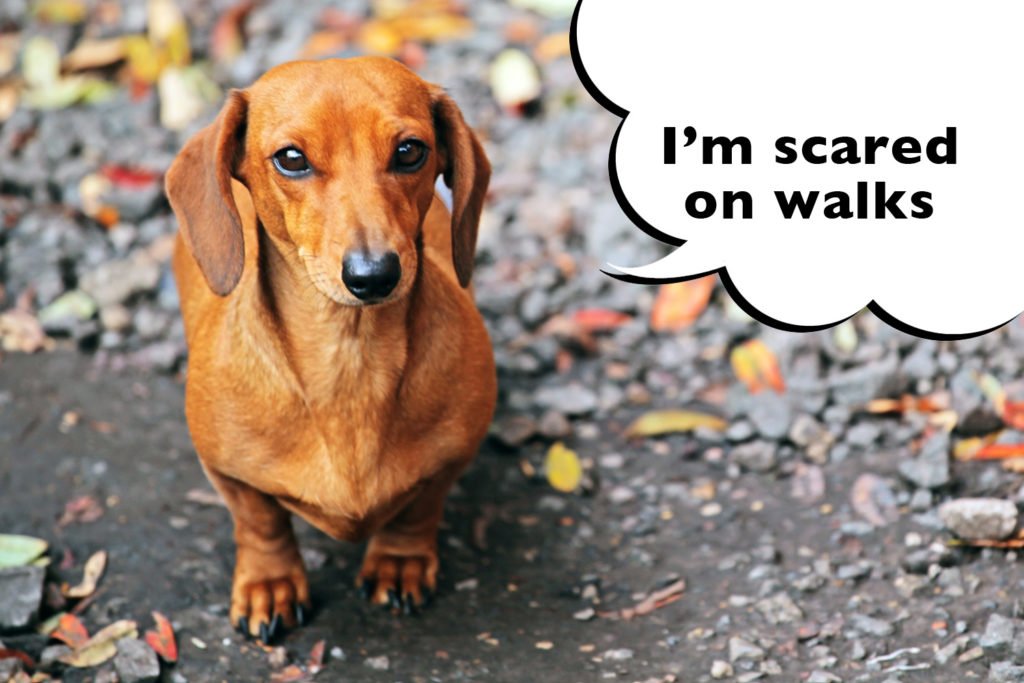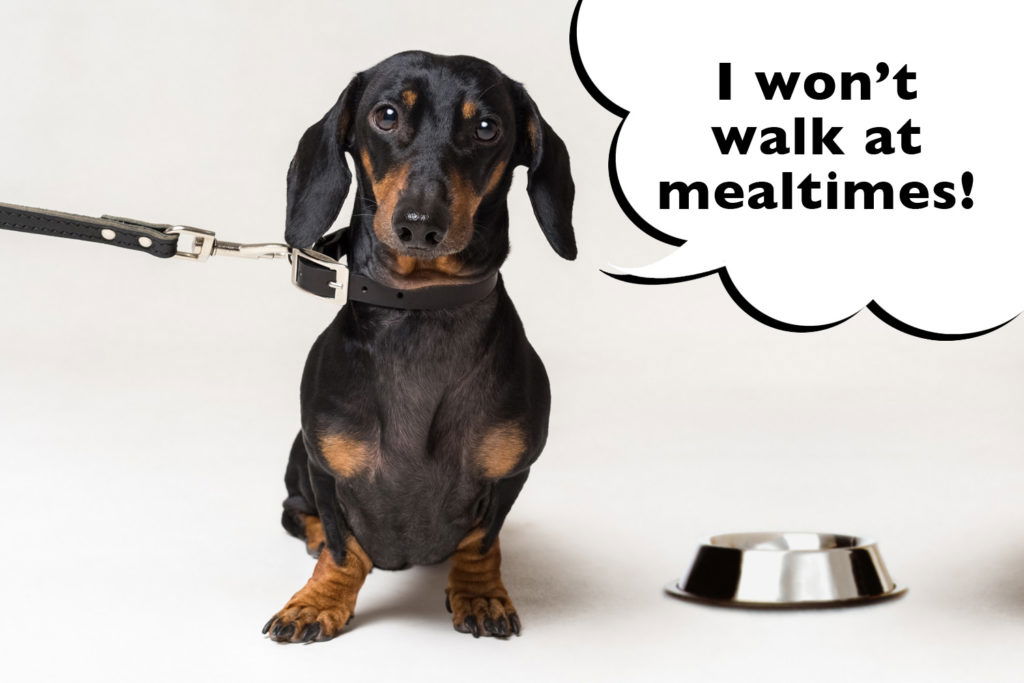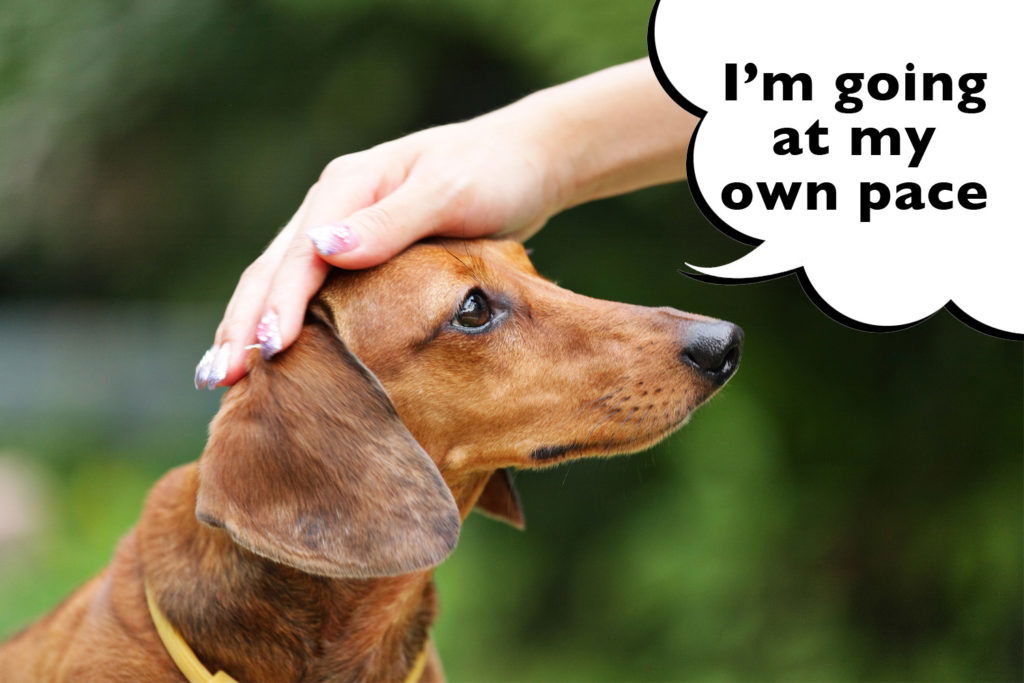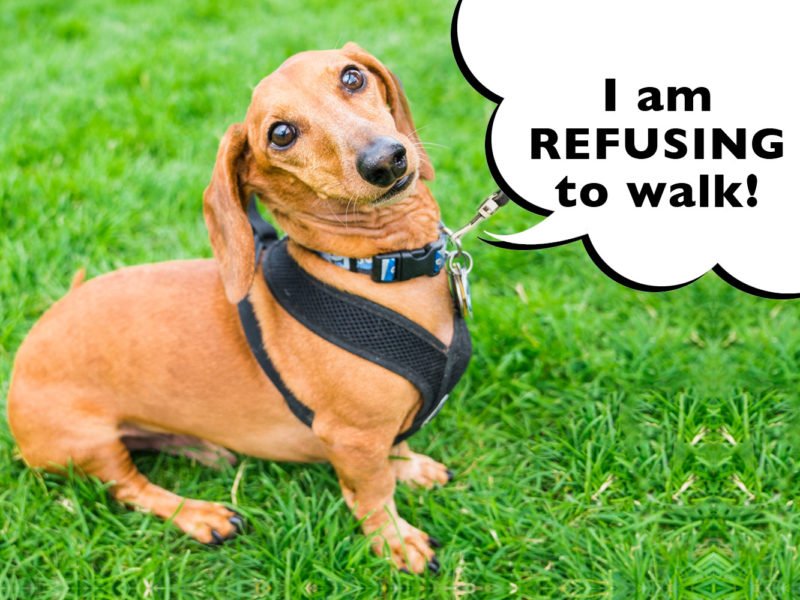Does your dachshund sit down or roll onto his back when you go for a walk? Does he point blank refuse to move? Does he constantly pull on the leash to try and get back home? Here’s everything you need to know about dachshunds and their sudden refusal to walk!
Why Does My Dachshund Refuse To Walk? Your dachshund may refuse to walk because he’s in pain, unwell, anxious, scared, uncomfortable in his harness, too cold or wet, hungry, getting older, or he’s a new puppy getting used to the sights, smells and sounds of the outside world.
So, before you get the leash out and set off to the park, there’s more you need to know! Read on to find out how to get your dachshund walking happily again.
This article is based on research and personal experience as a Dachshund owner of 10+ years. I’m not a Vet, qualified dog trainer or dog behaviourist.
Why Won’t My Dachshund Walk?
If you have a dachshund that refuses to walk, you’re not alone. Some hate walking and will do all they can to get back home. To fix it, you first need to work out why your dachshund won’t walk.
This is why a dachshund won’t walk:
- Your dachshund is in pain
- Your dachshund is unwell
- Your dachshund is scared
- Your dachshund is a puppy
- Your dachshund is a senior
- Your dachshund is uncomfortable
- Your dachshund is bored
- Your dachshund is cold
- Your dachshund is hungry!
This is what you need to know:
Your dachshund is in pain
A sudden refusal to walk could mean your dachshund is in pain. So, before you do anything else, check his feet and legs over to make sure he’s OK. He may have a stone, twig or thorn stuck inside his paw or leg that’s hurting when he walks. Run your hands down each leg, across his whole body and gently down his back, to see if he’s in any pain. Check to see if he’s limping or able to walk normally. Dachshunds are prone to back, hip and knee injuries so, If you think your dachshund may have hurt himself, he needs to be checked by a vet.
Your dachshund is unwell
If your dachshund’s sudden refusal walk is out of character, he could be unwell. It’s always best to rule out any medical problems before trying anything else. He may have a mild bug, stomach upset or possibly something more serious going on. Pay close attention to his general health and behaviour. Is he eating and drinking water? Does he seem lethargic? Does he look sad or tired? Does he generally seem out of sorts? If so, don’t force him to walk, contact your vet for advice.
Your dachshund is scared
The most common reason dachshunds refuse to walk is fear. Some dachshunds, especially those who aren’t socialised as puppies, can be anxious or scared of the outside world. Dachshunds are small dogs, known for being a bit clingy and overprotective. They may be unsure of strange noises, other dogs and meeting new people in the park. So, if your dachshund sits or lays down, rolls onto his back and refuses to move, he could be frightened, and you’ll need to work on that!

Your dachshund is a puppy
Dachshund puppies can only walk so far to begin with and mustn’t overdo things. Exercise needs to be limited for the first year until their growth plates have closed. Puppies can easily get frightened when they experience things for the first time. All the new sights, sounds and smells outside can be a bit overwhelming. They also need to learn how to walk and get used to the leash, collar or harness on their body. It won’t feel natural or comfortable to begin with, and he’ll need time to adjust. When you start walking together, your dachshund may refuse to move because he’s scared or unsure of his surroundings. It’s a big world out there for a small pup!
Your dachshund is a senior
As dachshunds age, they get more tired and might not be as keen to walk every day. Dachshunds are prone to back, hip and knee injuries, so may be a bit more stiff and achy as they get older. Some would much prefer to cosy up under warm blankets, rather than walk at the park! The problem is, dachshunds are also prone to obesity so do need some form of exercise every day – despite what they think!
Your dachshund is uncomfortable
Harnesses and collars can be uncomfortable for new pups at first. The fit of a harness is vitally important and should be done by someone experienced at the pet store. Getting this wrong could result in painful cuts or sores under his legs. If he stops walking or hates walking, the fit of the collar or harness could be the reason why.
Your dachshund is bored
Some dachshunds get bored of going to the same old places and doing the same walks. They’re smart dogs that need to experience new things and new smells.
Your dachshund is cold
Most dachshunds hate the rain and wind, and some refuse to go out in bad weather! They have short little legs and their bellies are low to the ground. Their bodies can get cold and wet outside and this can stop them wanting to walk.
Your dachshund is hungry!
Dachshunds are ruled by their stomachs! If you schedule your daily walks too close to meal times, he may stop walking because he fears missing out on food!

How Do I Get My Dachshund To Walk?
This is how to get your dachshund to walk:
- Check the collar or harness fits
- Socialise your dachshund
- Start training at home
- Work on desensitisation
- Walk at quiet times
- Carry him away from home
- Walk in front
- Vary the places you walk
- Make the walk fun
- Take things slow
- Keep your dachshund warm
- Go off leash
- Work with a dog behaviourist
- Speak to your vet
This is what you need to do:
Check the collar or harness fits
The fit of the collar or harness your dachshund wears is extremely important. Getting this wrong could make him less keen on walking!
Collar
The collar mustn’t be too tight or restrictive. Once it’s on your dachshund, you should be able to slip 2 fingers underneath it. You want it to be snug against his neck, but not so tight it’s uncomfortable.
Harness
The harness should be fitted by someone experienced at the pet store. Again, you want it to be snug, but not too tight. Take advice on the harness because, if you get this wrong, it could end up chafing against your dachshund’s delicate skin and rubbing him raw. Bad fitting harnesses can cause very sore cuts under the legs which could stop a dachshund walking.
Leash
Dachshunds are small dogs so it may be better to go for a leash that’s lightweight. If the leash is too heavy, it could be uncomfortable for your dachshund and stop him walking.
Socialise your dachshund
Some dachshund puppies refuse to walk because they’re scared and fearful of their surroundings. The best thing you can do for your dachshund is to socialise him from a young age. Socialised dachshunds that are used to other people, dogs, sights, sounds and smells, are much less likely to be nervous on walks. So book your dachshund in to puppy classes and get him used to new experiences.
For adult or rescue dachshunds that refuse to walk, join a local dachshund Facebook group. Most organise regular walks where your dachshund can socialise with other sausages! Nervous dachshunds tend to be more comfortable around their own kind. If the other dogs walk, it should encourage your dachshund to walk too. Socialisation builds confidence and group walks are a lot of fun!
Start training at home
If your dachshund is refusing to walk because he’s unsure of his collar, harness or leash, you need to get him used to them. Start by training him at home for 10-20 minutes every day.
- Put your dachshund’s collar or harness and leash on
- Don’t hold the leash at first.
- Let your dachshund wander freely around the home with the leash on
- Pick up the leash but don’t pull or tug at it
- Keep everything light and loose with no tension at all
- Walk your dachshund a short distance into the kitchen
- Praise your dachshund for walking well
- Give your dachshund a treat!
Keep doing this over and over until he finds it normal to walk on the leash at home. If you have a garden, use that too. Walk him around the garden on his leash, then back into the house for a treat. Swap out fatty treats for small chunks of cucumber, apple, carrot or banana.
Work on desensitisation
Some dachshunds can get really scared when walking away from home, so you need to work on desensitisation. Once he’s comfortable on his leash inside your home, you can then venture outside:
- Put your dachshund on his leash
- Open the front door
- Keep your front door open
- Walk your dachshund 5-10 metres away from your home
- Turn back and walk your dachshund back inside
- Praise your dachshund for walking well
- Give your dachshund a treat!
Keep doing this over and over and then gradually increase the distance you walk. It can take time to progress, but you will eventually get to the end of the road. From there, you can think about longer routes and trips to the park.
Walk at quiet times
If you have a nervous dachshund, the best thing you can do is walk him when there’s less people and dogs around. Go out early morning and build his confidence when it’s quiet. Keep the walks short so they’re a success, rather than go too far and spook him so it’s worse next time. Once dachshunds get spooked on a walk, they remember that place and it’s harder to get them to walk there again. Once he’s happy walking in a quiet place, choose somewhere with a few more people and dogs around, and then gradually build on that.

Carry him away from home
Dachshunds tend to be much better at walking back home, rather than away from it. So, another thing you can do is carry your dachshund away from home and let him walk back with you. You could also drive to the end of the road and walk back home together (but you’ll need to go back and get your car later!). If he pulls on the lead, stop or change directions and wait for him to calm down before continuing on.
Walk in front
Dachshunds are extremely loyal. They love being with you and hate missing out on anything you’re doing! Use this trait to your advantage to get him walking again.
- Ask a friend to help you walk your dachshund
- Get your friend to hold your dachshund’s leash
- You walk 10 metres in front of your friend and dachshund
- Your dachshund should then follow you
- Don’t call your dachshund or look back at him
- Keep walking forwards and let him follow you
- If he walks nicely, praise him and give him a treat
- Gradually reduce the distance between you and your friend over several walks
Keep doing this over and over and, eventually, he should end up walking happily by your side!
Vary the places you walk
It’s a good idea to vary the places you walk with your dachshund. If there’s a certain place where he always refuses to walk, try somewhere new. New places with new smells are much more exciting for dachshunds. They also have the added advantage of him not knowing how far he’s walked!
Make the walk fun
It can be stressful when your dachshund won’t walk. The stress and anxiety you feel can rub off on your dachshund, especially if his leash is tense. Dogs pick up on emotions and he may start thinking there’s something to worry about. So, keep things calm and positive and try to make the walk interesting and fun. As crazy as it sounds, if you see a bench say ‘Oooo let’s go and look at that bench’ and then sit down for a minute. You could also crouch down or sit on the ground and point at things in the grass. He should then come to investigate what you’re looking at. Dachshunds love being involved in everything – so get him involved!
Take things slow
If your stubborn little dachshund is refusing to walk, take things slow. Don’t ever pull at the leash or drag him along. Dachshunds have very fragile backs and 1 in 4 are prone to Intervertebral Disc Disease. It’s better to stand quietly in one spot and wait calmly for any tension to pass. Don’t shout at your dachshund either. Any stress or anxiety will make the problem much worse, especially if he’s scared already. By breaking the walk into small sections and slowing down the pace, you’ll make progress and the walks should get easier over time.

For senior dachshunds, try shortening your walks and take regular breaks so your dachshund doesn’t overdo things. Go at his pace and be mindful of his limits. Sit on a bench and let him enjoy being outside without being forced to walk. Get a general health check at the vets and consider medications to help with any stiff joints.
Keep your dachshund warm
If your dachshund refuses to walk because it’s raining and he’s cold, get him a sweater, fleece or coat! A sweater or fleece will keep him warm and a raincoat will keep him dry! If you protect him from the elements, he’s much more likely to walk!
Go off leash
Some dachshunds that refuse to walk do much better when you take the leash off. Obviously, you have to train your dachshund to walk off leash and be 100% sure they’e safe and won’t run off. Some dachshunds are good at this, but others won’t listen to a thing you say! Dachshunds are hunters by nature and, if he sees a squirrel or rabbit, he could run and you won’t be able to catch him. If he doesn’t listen to your commands, it’s a real danger so you have to use caution.
Walk with a dog behaviourist
If your dachshund is refusing walk and you’re really struggling with him, speak to a local dog behaviourist. They can go on a walk with you, help you get to the route of the problem and then show you how to fix it.
Speak to your vet
If your dachshund’s refusal to walk is extreme or distressing, book a general health check and speak to your vet for advice. Sometimes there are emotional, medical or age related reasons why your dachshund can’t and won’t walk. Some dachshunds might need anxiety treatments, and those with joint or back problems may be helped with medications.
So, there you have it! It’s common for dachshunds to refuse to walk, but there are things you can do. Take your dachshund for a general health check, build his confidence by starting your training at home, venture to the park at quiet times and take things at his pace. If he still refuses to walk, speak to a behaviourist or your vet for advice.
What do I do next?
If you read all the way to the end of this article, you’re exactly the sort of person I’d LOVE to join my Facebook Group. Your support for my blog means everything to me so, if you enjoyed this article or found it helpful, please kindly share below. Thank you! 💋








